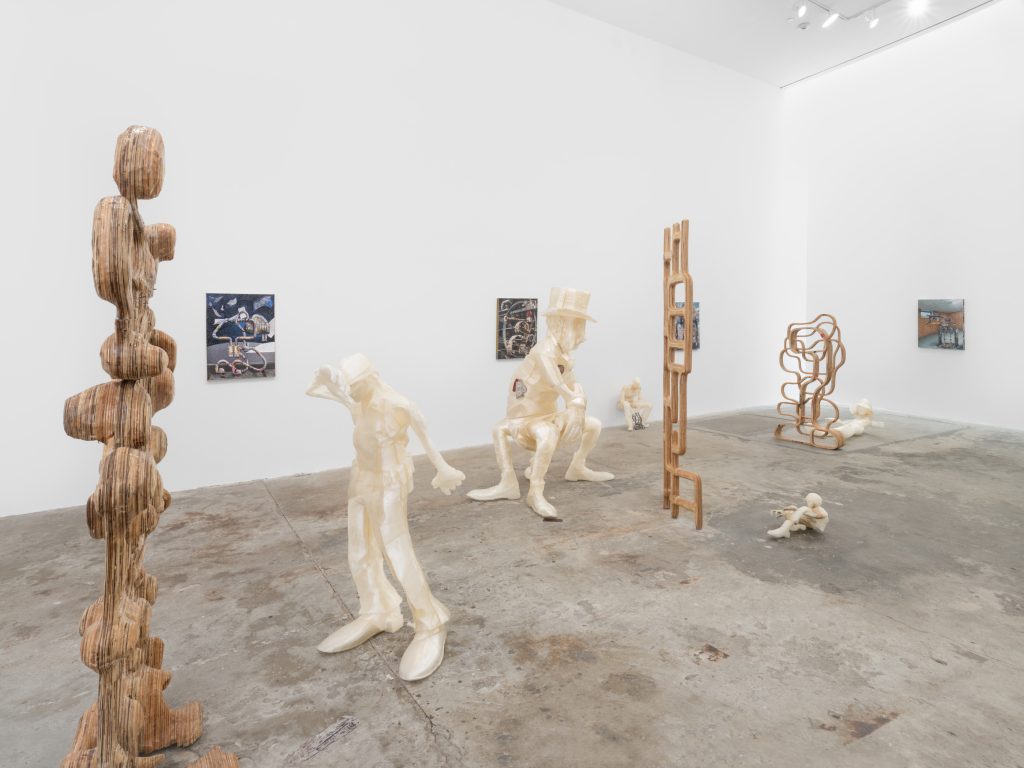Artist Jacques Louis Vidal’s “Dead End Jobs That Kill” Exhibit at Real Pain Gallery
A solo show centered around imperfection, materiality and technology at the gallery’s NYC outpost

The varied wondrous works by Paris-born, Brooklyn-based artist Jacques Louis Vidal at NYC’s Real Pain outpost explore the imperfection of materiality and technology. Within Vidal’s solo show Dead End Jobs That Kill (on now through 10 October), these sculptures and wall-hung pieces incorporate everything from coated plywood to cut paper and PLA plastic; some processes behind the work demonstrate evidence of Vidal’s hands, others are born from 3D printing. A sense of offbeat whimsy emanates from each piece, whether it’s figurative or abstract—and altogether the works provoke viewers to ponder each and every decision that went into their creation. Perhaps unsurprisingly, Vidal’s intention behind it all is deeply considered and adheres to its own imaginative logic, as well.

The show’s very title is the first entry-point in to Vidal’s vision. It “is a rejected title for a reality TV show about hard jobs,” Vidal tells us. “The exhibition attempts to illustrate ways that a line or body or material is forced to move in the interest of a larger vision or structure.” For instance, he explains, “A narrativized version of this might go something like this: an employee at a job is forced to work repetitively at a speed which alters their bone structure over several years, so they can no longer walk without pain. Now unemployed, they develop more upper body strength in their free time, and also take a coding bootcamp in order to change careers toward UX design. Now they are a coder with extra dexterous hands meeting another coder online with extra good hands, and producing a child coder with super-human dexterity.”
 “That child is a student learning a certain set of ethics because they are part of a school which promotes those ethics and—having learned them—going out into the world and enacting those ethics in a political dimension upon other people,” he continues. “Then a soldier or policeman subjects their own body and other people’s bodies to enforcing these proposed laws that satisfy those ethics. Now, thoroughly policed and sanitized, that society has become a model of those ethics in action toward a nice living style. Within that society an artist is given carte blanche to move freely between politics, comedy, religion, drug addiction and science and present the whole lifestyle as a metaphor for constraint.”
“That child is a student learning a certain set of ethics because they are part of a school which promotes those ethics and—having learned them—going out into the world and enacting those ethics in a political dimension upon other people,” he continues. “Then a soldier or policeman subjects their own body and other people’s bodies to enforcing these proposed laws that satisfy those ethics. Now, thoroughly policed and sanitized, that society has become a model of those ethics in action toward a nice living style. Within that society an artist is given carte blanche to move freely between politics, comedy, religion, drug addiction and science and present the whole lifestyle as a metaphor for constraint.”

Observations of chaos and imperfection in the work offer insight, as well—as does the use of 3D printing. “3D printing as a metaphor is a failed blip of 2010s utopia,” Vidal says. “It will never be more than that, sadly, but that’s probably good. As a technology, it is older than most people assume. It is, at its most basic, drawings made out of plastic piled on top of one another thousands and thousands of times, which is so hilariously dumb and miraculous,” the artist says.

“As mass-marketed tech, it emerged ironically from the expiration of military patents over the last 20 years,” Vidal says. “I find that things that are 3D printed do not fully know what they are, as we also don’t know what they are. They are full of contradictions: exact yet inherently error prone, sterile and yet nasty, and they are very human like art is. It’s useful as a kind of lost metaphor now, and that is useful to me—it’s miraculous.” In many ways, a miraculous life, albeit an unreal iteration, runs through all Vidal’s works in the exhibition, making them something more than sculptures.
Images courtesy of Real Pain Gallery












